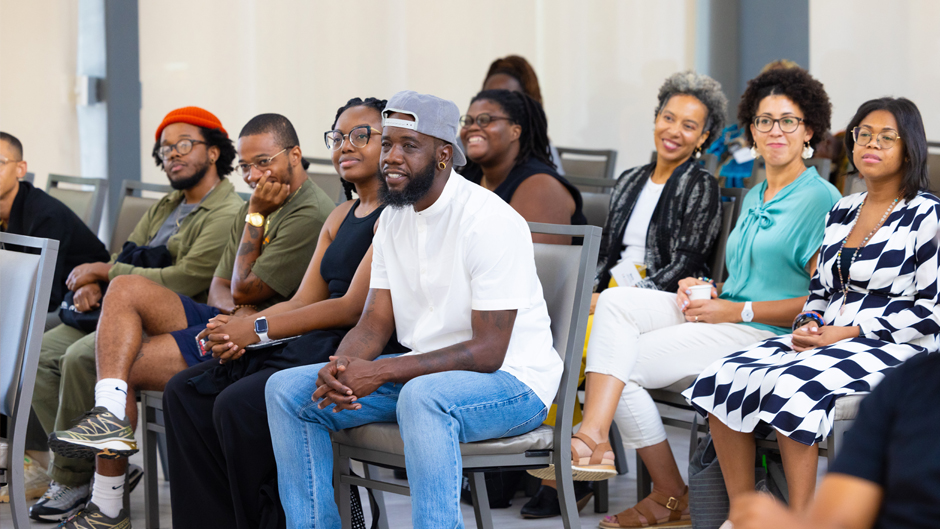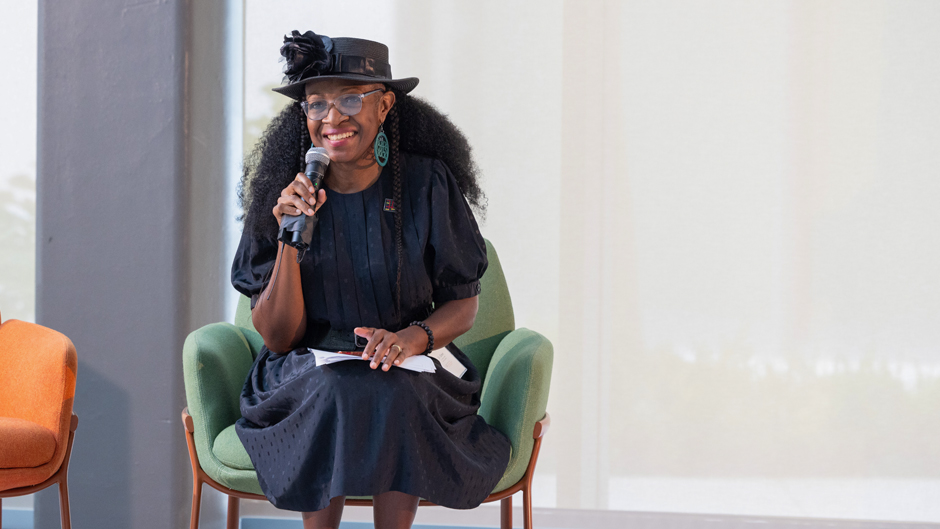Dozens of artists, writers, curators, scholars, and art collectors came together to celebrate the evolution of the Miami Black arts community Thursday for “Still Here: Generations of Black Miami Artmaking,” the first symposium hosted by the University of Miami’s Center for Global Black Studies, in partnership with Commissioner, an art membership program that supports local contemporary artists in Miami.
“The goal for this convening is to catalyze scholarship on Black Miami art and artists,” said Donette Francis, a professor of English in the College of Arts and Sciences who also directs the Center for Global Black Studies and opened the event. “It’s about the diverse places they are from, and the generational histories and influences.”
The event began Thursday at the University’s Lakeside Pavilion and is free for students and faculty and staff members. It continued Friday in the Shalala Student Center. Speakers and presenters include artists and scholars from across the country, who grew up in South Florida, or who continue to produce art locally. Francis and other members of the center hope that the event will help draw attention to the wealth of Black artistic talent and knowledge in the greater Miami area.

“Black Miami has an aesthetic shaped by the uniqueness of this place,” Francis added. “There’s an ecosystem among Black Miami artists that registers in how they show up for each other, cross reference each other, and live comfortably among each other. For museum audiences and beyond, I unequivocally believe that the best scholarship about Black Miami art begins here.”
One of the first presenters was Sharony Green, an associate professor of History at the University of Alabama, former journalist and a University of Miami alumna. Green spoke about her new book, which focuses on the end of writer Zora Neale Hurston’s life. It was a time when the esteemed Harlem Renaissance author of “Their Eyes Were Watching God,” was struggling financially and emotionally, so she escaped to Honduras.
But Green also explained that Hurston often escaped the New York cold to live in South Florida. Still, even as an award-winning writer, Hurston had to clean homes in Miami Beach to pay her bills.
“Hemingway had Havana and Zora had Honduras and Miami,” said Green, who was born in Coconut Grove, but grew up in the Miami Gardens neighborhood of Carol City.
In doing her research on Hurston, Green also discovered that while they lived decades apart, the women had many similarities. They were both writers who grew up in segregated communities in Florida. And Green’s grandmother knew some of the same South Florida leaders that Hurston did.
Many shared experiences among artists surfaced throughout the discussion panels on Thursday. In a session titled “Migration and Memories,” artist Juana Valdes, who immigrated from Cuba and grew up in Miami, spoke alongside artist Morel Doucet, who immigrated from Haiti, and was raised in North Miami. Both artists use ceramics, painting, and mixed media to explore themes of migration, displacement, and climate change in their art. Moderated by Nhadya Lawes, a University of Miami alumna who now works as an arts associate for the Knight Foundation, the artists discussed how they infuse their immigrant experiences into their work.
“When we came to the U.S., my family struggled trying to find housing in Miami without speaking English. There was also no space for us in a predominantly white Cuban community in Miami,” Valdes said. “So, my art sometimes has a hard time fitting into shows because they don’t represent blackness in typical ways. It’s made to make you be in an uncomfortable place.”
Despite their hurdles to assimilate to a new country with a new language, many artists including Doucet, mentioned that several other Miami artists served as mentors and helped encourage them to pursue art further. Those include Loni Johnson, an artist and educator who will participate in a Friday panel, and Charles Humes, Jr. last year’s fellow in the Center for Global Black Studies, who is also speaking on Friday.
“Along my entire early education, there was never the idea for Black representation of a young artist,” Doucet said. “But my mom gave me the space and representation to excel in the arts.”
In later panels, artists T. Elliot Mansa, Sydney Maubert, and Chris Friday talked about how to illustrate the unique experience of growing up Black in Miami. Maubert, who graduated in 2020 from the School of Architecture, grew up in Homestead as the daughter of a Cuban mother and Haitian father. Maubert is now a Strauch fellow at Cornell University. Her murals have been featured at the School of Law, and at Yale University, where she earned a master’s in architecture.
Roland Woods, Jr. graduated from the University of Miami in 1971, and was one of the senior Black artists at the symposium Thursday. In 1969, Woods and a few of his classmates formed the Black Arts Workshop and would meet in Coconut Grove and teach art to younger students. The organization continued through the late 1980s, but Woods is still an active painter, creating works in the cubist style, with baroque techniques that feature African themes. He was glad to be a part of one of the panels with watercolor painter Jared McGriff.
“It’s great to highlight the many accomplishments of the Black arts community,” Woods said.
Friday, who infuses meaningful images of Black life in her art agreed, and noted that simply bringing together so many people invested in the Miami art community was a major step forward.
“This room is full of people who before I knew them, I knew their work,” Friday said. “And it keeps me motivated and inspired to continue.”
Franklin Sirmans, director of the Perez Art Museum Miami and a New York native, said the first day of the conference enlightened him about just how much art history there is in Miami. He, along with Francis, and junior Deitrick Knatt, hope that this is the start of many more gatherings.
“I’m so glad we have this opportunity because it really sets a precedent for what we can do as Black Miami artists,” said Knatt, an aspiring photographer and storytelling artist. “But it’s also a great networking opportunity to meet other artists.”
Friday’s panels will feature Black photography, a discussion on making art public, and another panel on curating Black Miami with Dejha Carrington, a cofounder of Commissioner and Tanya Desdunes, from Diaspora Vibe Cultural Arts Incubator.
“Still Here: Generations of Black Miami Artmaking” was sponsored by the Terra Foundation for American Art and the Mellon Foundation.

